2025年中考英语二轮复习题型突破课件:专题十三句子的种类(共21张PPT)
文档属性
| 名称 | 2025年中考英语二轮复习题型突破课件:专题十三句子的种类(共21张PPT) | 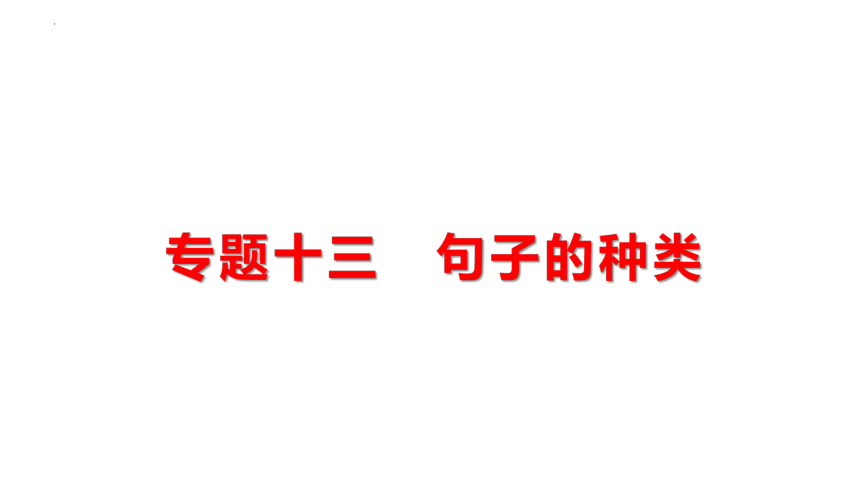 | |
| 格式 | pptx | ||
| 文件大小 | 353.8KB | ||
| 资源类型 | 教案 | ||
| 版本资源 | 通用版 | ||
| 科目 | 英语 | ||
| 更新时间 | 2025-01-01 10:43:08 | ||
图片预览

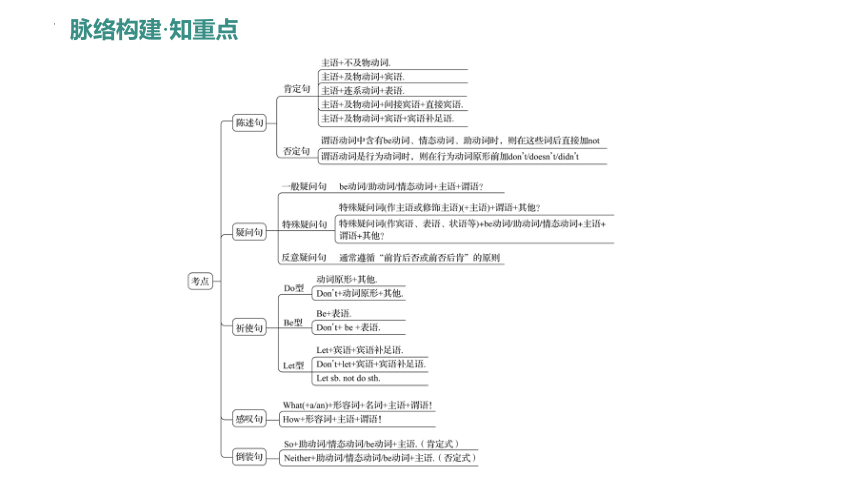

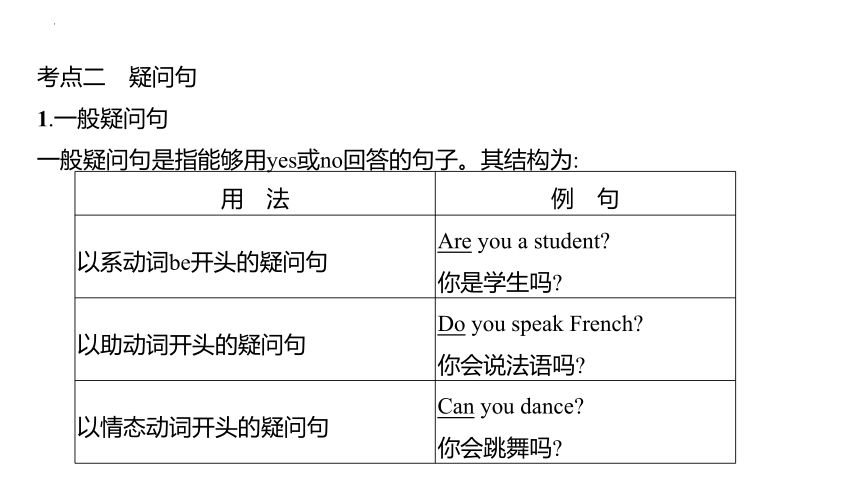
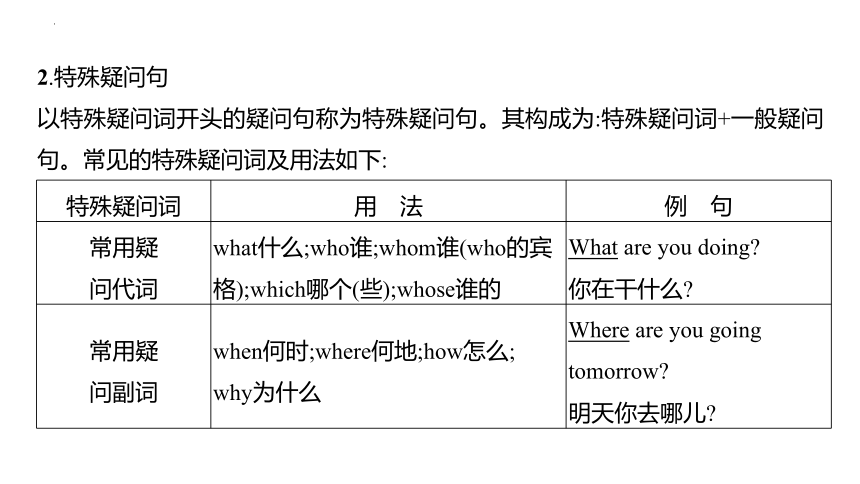
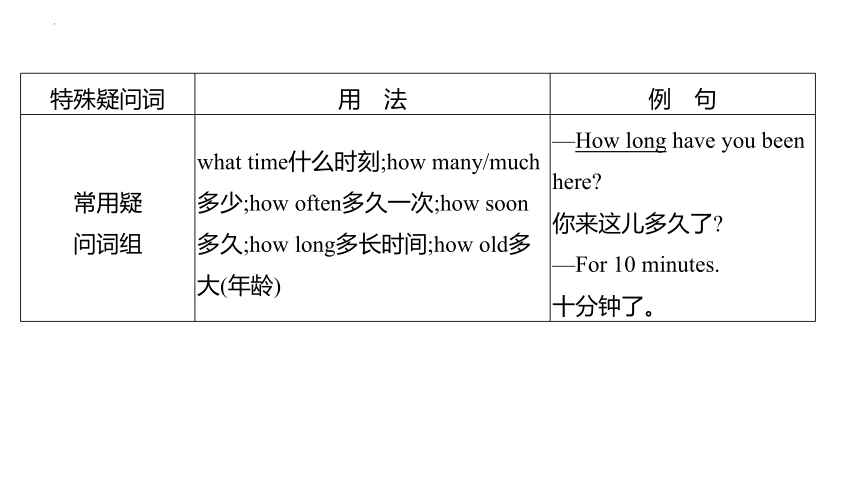


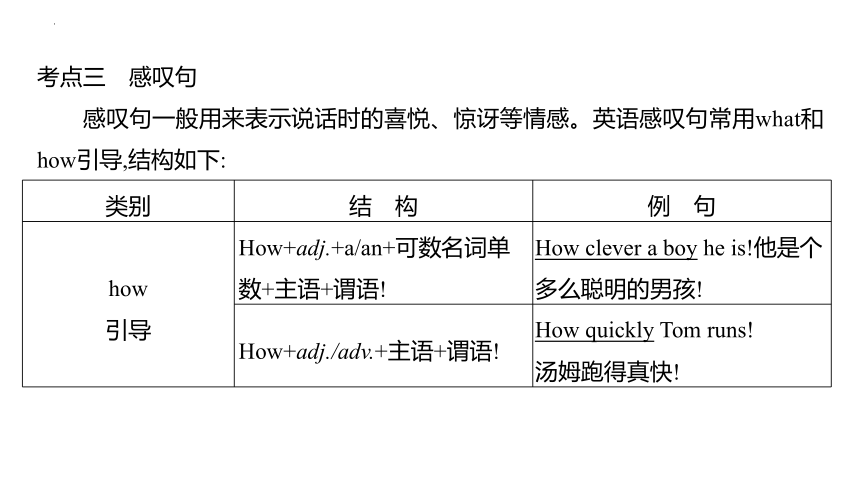
文档简介
(共21张PPT)
专题十三 句子的种类
脉络构建·知重点
考点一 五大基本句型
语法解读·攻核心
句型结构 例 句
S+V(主+谓) The sun is shining.太阳正照耀着。
S+LV+P(主+系+表) This is an English-Chinese dictionary.这是一本英
汉字典。
S+V+O(主+谓+宾) Who knows the answer
谁知道答案
S+V+IO+DO(主+谓+间宾+ 直宾) She ordered herself a new dress.她给她自己定了一
条新裙子。
S+V+O+C(主+谓+宾+宾补) They painted the door green.
他们把门漆成了绿色。
考点二 疑问句
1.一般疑问句
一般疑问句是指能够用yes或no回答的句子。其结构为:
用 法 例 句
以系动词be开头的疑问句 Are you a student
你是学生吗
以助动词开头的疑问句 Do you speak French
你会说法语吗
以情态动词开头的疑问句 Can you dance
你会跳舞吗
2.特殊疑问句
以特殊疑问词开头的疑问句称为特殊疑问句。其构成为:特殊疑问词+一般疑问句。常见的特殊疑问词及用法如下:
特殊疑问词 用 法 例 句
常用疑 问代词 what什么;who谁;whom谁(who的宾 格);which哪个(些);whose谁的 What are you doing
你在干什么
常用疑 问副词 when何时;where何地;how怎么; why为什么 Where are you going
tomorrow
明天你去哪儿
特殊疑问词 用 法 例 句
常用疑 问词组 what time什么时刻;how many/much 多少;how often多久一次;how soon 多久;how long多长时间;how old多 大(年龄) —How long have you been
here
你来这儿多久了
—For 10 minutes.
十分钟了。
3.选择疑问句
选择疑问句是指提出两个或两个以上可能的答案供对方选择的句式。前一部分是一般疑问句或特殊疑问句,后面加上or提供给对方其他条件,让对方根据实际情况进行选择回答。
Would you like a gin,a whisky,or a beer
你是要喝杜松子酒,威士忌,还是啤酒
【典题链接】
①(2024·白银武威)—______ was the zipper invented
—In 1893.
A.When B.How C.Why D.Where
②(2024·白银中考) I can read faster by reading word groups.(对画线部分提问)
______ _____ you read faster
How
can
考点三 感叹句
感叹句一般用来表示说话时的喜悦、惊讶等情感。英语感叹句常用what和how引导,结构如下:
类别 结 构 例 句
how 引导 How+adj.+a/an+可数名词单 数+主语+谓语! How clever a boy he is!他是个
多么聪明的男孩!
How+adj./adv.+主语+谓语! How quickly Tom runs!
汤姆跑得真快!
类别 结 构 例 句
what 引导 What+a/an+adj.+可数名词单 数+ 主语 + 谓语! What a beautiful mountain it is!
多么美丽的山啊!
What+adj.+可数名词复数+ 主语 + 谓语! What great inventions he has
made!
他的发明多么伟大啊!
What+adj.+不可数名词 + 主语 + 谓语! What bad weather it is today!
今天的天气多么糟糕啊!
【典题链接】
①(2024·遂宁中考)—Hi, guys! Our team won the first place in the table tennis
match.
— ______exciting news it is! We are so happy about it.
A.What B.How
C.What an D.How an
②Our school is very beautiful.(改为感叹句)
______ __________our school is!
How
beautiful
考点四 祈使句
祈使句是省略了主语you,以动词原形开头的句子,常用来发出命令、提出要求或建议。
1.肯定形式的祈使句
Do型 动词原形(+宾语)+其他成分 Please have a seat.
请坐。
Be型 Be+表语(名词或形容词)+其他成分 Be quiet! 安静!
Let型 Let+宾语+动词原形+其他成分 Let me help you.
让我帮助你。
2.否定形式的祈使句
(1)Do型和Be型的否定式都是在句首加Don’t。例如:
①Don’t forget me! 不要忘记我!
②Don’t be late for school! 上学不要迟到!
(2)Let型的否定式有两种:“Don’t +let+宾语+动词原形+其他成分”和“Let+宾语+not+动词原形+其他成分”。例如:
Don’t let him go./Let him not go.别让他走。
(3)有些可用no开头,用来表示禁止性的祈使句。例如:
No smoking!禁止吸烟!
【典题链接】
①(2024·绥化中考) “Li Ming, ______your homework first, and then you can watch
TV for 30 minutes,” said his mum.
A.does B.did C.do
②(2024·白银中考) Open the door.(改为否定句)
______ ______ the door.
Don’t
open
考点五 倒装句
英语句子一般主语在前,谓语在后,即“主语+谓语”。有时因为语法结构的要求或为了表达特殊的强调部分,会把谓语的全部或一部分放到主语之前,这种句子叫倒装句。在中学阶段常见的倒装句式有以下几种。
1. 以here、there、out、in、down、away等表示方位的副词开头的句子中,如果主语是名词,要用倒装句,谓语动词的形式由倒装句句尾的主语确定。
例如:
There comes the bus.公共汽车来了。
Here are the results of the test.
这是考试的结果。
2.So+助动词/系动词/情态动词+主语
表示与上文提到的肯定情况相同,译为“另一个人也……”。
例如:
—Jack likes pork for lunch.
杰克午饭喜欢吃猪肉。
—So does my brother.我弟弟也是。
【温馨提示】So+主语+助动词/系动词/情态动词
表示“确实如此”,是对上文提到的肯定情况表示认可和肯定。例如:
—She is a beautiful girl. 她是个漂亮的女孩。
—So she is. 她的确如此。
3.Neither+助动词/系动词/情态动词+主语
表示与上文提到的否定情况相同。例如:
—Jim doesn’t like noodles for breakfast.
吉姆早餐不喜欢吃面条。
—Neither does my sister.我妹妹也不喜欢。
【典题链接】
①(2024·龙东中考)—It was the Dragon Boat Festival last Thursday. I watched the
boat races by the lake.
— ______, but I didn’t see you there.
A.So did I B.So I did
C.Neither did I
②He wasn’t late for school, ___________ _____ __. (我也没有)
neither/nor
was
I
Ⅰ.根据句意,从方框内选择合适的单词填空,可重复使用
much,what,how,did,why,has,so,neither
1._____ you dance with your friends last night
2.How ______ sugar do you need
3.______ do you think of the story
4.______ slowly the boy is drawing!
5.______ useful advice you took!
6.He doesn’t like the film,________ do I.
7.My mother likes wearing beautiful clothes.____ do I.
8.Lucy is late.I wonder _____ she couldn’t come earlier.
9._____ your brother read the novel yet
10.______ amazing the concert is!
语法巩固·提升练
Did
much
What
How
What
neither
So
why
Has
How
Ⅱ.词语运用
阅读下面短文,在空白处填入一个适当的单词或括号内单词的正确形式。
Jane is a warm-hearted girl.She always 1.______ (help) others.She is only ten
years old, 2.____ she has big ideas of helping other kids.
Jane went to a winter camp 3.___ the age of eight.During her stay in the camp,
she visited some kids in poor areas.After getting back home, she 4._____ (keep)
thinking, “How can I help those kids ”
One morning, while Jane walked outside, she saw some 5._________ (child)
selling lemon juice to raise money.Then she came up with 6.____idea.
helps
but
at
kept
children
an
Jane set up her 7._____ (one) lemon juice stand (摊位).In a week, it made $52
and she helped 12 kids with it.She felt very excited when she saw smiles on 8.______
(they) faces.She was 9.______ (real) glad that she helped others.
Up till now, she has already raised 10.______ (many) than $17,000! She is going
to spend the money on clothes, toys and books for poor kids.
first
their
really
more
专题十三 句子的种类
脉络构建·知重点
考点一 五大基本句型
语法解读·攻核心
句型结构 例 句
S+V(主+谓) The sun is shining.太阳正照耀着。
S+LV+P(主+系+表) This is an English-Chinese dictionary.这是一本英
汉字典。
S+V+O(主+谓+宾) Who knows the answer
谁知道答案
S+V+IO+DO(主+谓+间宾+ 直宾) She ordered herself a new dress.她给她自己定了一
条新裙子。
S+V+O+C(主+谓+宾+宾补) They painted the door green.
他们把门漆成了绿色。
考点二 疑问句
1.一般疑问句
一般疑问句是指能够用yes或no回答的句子。其结构为:
用 法 例 句
以系动词be开头的疑问句 Are you a student
你是学生吗
以助动词开头的疑问句 Do you speak French
你会说法语吗
以情态动词开头的疑问句 Can you dance
你会跳舞吗
2.特殊疑问句
以特殊疑问词开头的疑问句称为特殊疑问句。其构成为:特殊疑问词+一般疑问句。常见的特殊疑问词及用法如下:
特殊疑问词 用 法 例 句
常用疑 问代词 what什么;who谁;whom谁(who的宾 格);which哪个(些);whose谁的 What are you doing
你在干什么
常用疑 问副词 when何时;where何地;how怎么; why为什么 Where are you going
tomorrow
明天你去哪儿
特殊疑问词 用 法 例 句
常用疑 问词组 what time什么时刻;how many/much 多少;how often多久一次;how soon 多久;how long多长时间;how old多 大(年龄) —How long have you been
here
你来这儿多久了
—For 10 minutes.
十分钟了。
3.选择疑问句
选择疑问句是指提出两个或两个以上可能的答案供对方选择的句式。前一部分是一般疑问句或特殊疑问句,后面加上or提供给对方其他条件,让对方根据实际情况进行选择回答。
Would you like a gin,a whisky,or a beer
你是要喝杜松子酒,威士忌,还是啤酒
【典题链接】
①(2024·白银武威)—______ was the zipper invented
—In 1893.
A.When B.How C.Why D.Where
②(2024·白银中考) I can read faster by reading word groups.(对画线部分提问)
______ _____ you read faster
How
can
考点三 感叹句
感叹句一般用来表示说话时的喜悦、惊讶等情感。英语感叹句常用what和how引导,结构如下:
类别 结 构 例 句
how 引导 How+adj.+a/an+可数名词单 数+主语+谓语! How clever a boy he is!他是个
多么聪明的男孩!
How+adj./adv.+主语+谓语! How quickly Tom runs!
汤姆跑得真快!
类别 结 构 例 句
what 引导 What+a/an+adj.+可数名词单 数+ 主语 + 谓语! What a beautiful mountain it is!
多么美丽的山啊!
What+adj.+可数名词复数+ 主语 + 谓语! What great inventions he has
made!
他的发明多么伟大啊!
What+adj.+不可数名词 + 主语 + 谓语! What bad weather it is today!
今天的天气多么糟糕啊!
【典题链接】
①(2024·遂宁中考)—Hi, guys! Our team won the first place in the table tennis
match.
— ______exciting news it is! We are so happy about it.
A.What B.How
C.What an D.How an
②Our school is very beautiful.(改为感叹句)
______ __________our school is!
How
beautiful
考点四 祈使句
祈使句是省略了主语you,以动词原形开头的句子,常用来发出命令、提出要求或建议。
1.肯定形式的祈使句
Do型 动词原形(+宾语)+其他成分 Please have a seat.
请坐。
Be型 Be+表语(名词或形容词)+其他成分 Be quiet! 安静!
Let型 Let+宾语+动词原形+其他成分 Let me help you.
让我帮助你。
2.否定形式的祈使句
(1)Do型和Be型的否定式都是在句首加Don’t。例如:
①Don’t forget me! 不要忘记我!
②Don’t be late for school! 上学不要迟到!
(2)Let型的否定式有两种:“Don’t +let+宾语+动词原形+其他成分”和“Let+宾语+not+动词原形+其他成分”。例如:
Don’t let him go./Let him not go.别让他走。
(3)有些可用no开头,用来表示禁止性的祈使句。例如:
No smoking!禁止吸烟!
【典题链接】
①(2024·绥化中考) “Li Ming, ______your homework first, and then you can watch
TV for 30 minutes,” said his mum.
A.does B.did C.do
②(2024·白银中考) Open the door.(改为否定句)
______ ______ the door.
Don’t
open
考点五 倒装句
英语句子一般主语在前,谓语在后,即“主语+谓语”。有时因为语法结构的要求或为了表达特殊的强调部分,会把谓语的全部或一部分放到主语之前,这种句子叫倒装句。在中学阶段常见的倒装句式有以下几种。
1. 以here、there、out、in、down、away等表示方位的副词开头的句子中,如果主语是名词,要用倒装句,谓语动词的形式由倒装句句尾的主语确定。
例如:
There comes the bus.公共汽车来了。
Here are the results of the test.
这是考试的结果。
2.So+助动词/系动词/情态动词+主语
表示与上文提到的肯定情况相同,译为“另一个人也……”。
例如:
—Jack likes pork for lunch.
杰克午饭喜欢吃猪肉。
—So does my brother.我弟弟也是。
【温馨提示】So+主语+助动词/系动词/情态动词
表示“确实如此”,是对上文提到的肯定情况表示认可和肯定。例如:
—She is a beautiful girl. 她是个漂亮的女孩。
—So she is. 她的确如此。
3.Neither+助动词/系动词/情态动词+主语
表示与上文提到的否定情况相同。例如:
—Jim doesn’t like noodles for breakfast.
吉姆早餐不喜欢吃面条。
—Neither does my sister.我妹妹也不喜欢。
【典题链接】
①(2024·龙东中考)—It was the Dragon Boat Festival last Thursday. I watched the
boat races by the lake.
— ______, but I didn’t see you there.
A.So did I B.So I did
C.Neither did I
②He wasn’t late for school, ___________ _____ __. (我也没有)
neither/nor
was
I
Ⅰ.根据句意,从方框内选择合适的单词填空,可重复使用
much,what,how,did,why,has,so,neither
1._____ you dance with your friends last night
2.How ______ sugar do you need
3.______ do you think of the story
4.______ slowly the boy is drawing!
5.______ useful advice you took!
6.He doesn’t like the film,________ do I.
7.My mother likes wearing beautiful clothes.____ do I.
8.Lucy is late.I wonder _____ she couldn’t come earlier.
9._____ your brother read the novel yet
10.______ amazing the concert is!
语法巩固·提升练
Did
much
What
How
What
neither
So
why
Has
How
Ⅱ.词语运用
阅读下面短文,在空白处填入一个适当的单词或括号内单词的正确形式。
Jane is a warm-hearted girl.She always 1.______ (help) others.She is only ten
years old, 2.____ she has big ideas of helping other kids.
Jane went to a winter camp 3.___ the age of eight.During her stay in the camp,
she visited some kids in poor areas.After getting back home, she 4._____ (keep)
thinking, “How can I help those kids ”
One morning, while Jane walked outside, she saw some 5._________ (child)
selling lemon juice to raise money.Then she came up with 6.____idea.
helps
but
at
kept
children
an
Jane set up her 7._____ (one) lemon juice stand (摊位).In a week, it made $52
and she helped 12 kids with it.She felt very excited when she saw smiles on 8.______
(they) faces.She was 9.______ (real) glad that she helped others.
Up till now, she has already raised 10.______ (many) than $17,000! She is going
to spend the money on clothes, toys and books for poor kids.
first
their
really
more
同课章节目录
